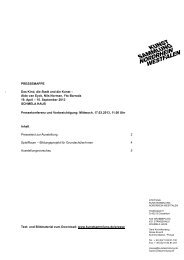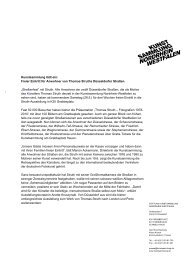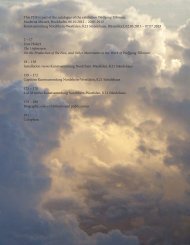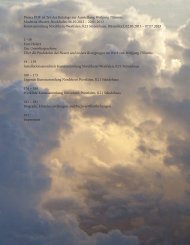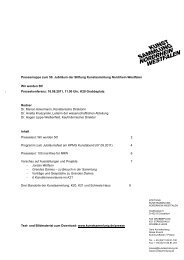Download online catalog (pdf)
Download online catalog (pdf)
Download online catalog (pdf)
Create successful ePaper yourself
Turn your PDF publications into a flip-book with our unique Google optimized e-Paper software.
Susanne’s lowered gaze (in Susanne, No Bra, 2006), with the line of her hair encircling her head<br />
like an incomplete figure of eight, but also the disturbed, interrupted, lurking monochromaticism<br />
of the Lighter and Silver works – they all open up the longer you look at them, the longer<br />
you are with them, to a perceiving in terms of forces and affects. They alert us to the fact that<br />
all images are fabricated.<br />
In Defence of One’s Own Interests<br />
Wolfgang Tillmans does a great deal to communicate important tenets of his own aesthetic<br />
theory. Aesthetic theory? It would surely be more appropriate to talk of theory-praxis or<br />
praxis-theory, for the systems and methods he uses are the result of his own empiricalexperimental<br />
investigations into the material potential of photography, investigations that also<br />
concern his interest in an artistic language of surprise, of spontaneous occurrences, of emergence.<br />
On another level of discourse, above all in the medium of the artist’s interview, Tillmans<br />
has repeatedly pointed out how important it is to him that his distinctive, sometimes distinctly<br />
Romantic preferences and convictions, his way of perceiving the world, directly impact on his<br />
artistic decisions and on the forms his works take. And as he says, the exhibitions, the installations<br />
of individual pictures reflect the way that he sees the world he lives in; at the same time,<br />
as he explains, they are also models of a world that he would like to live in. 20<br />
However, in order to realise this demiurgic project of a subjective agency, without<br />
stumbling into the trap of an ideology of creativity, it is necessary to reflect on the ‘conditions’<br />
cited by Rancière. In interviews and in his occasional texts Tillmans himself has repeatedly<br />
returned to certain aspects of the conditionality of his own praxis. Amongst these, not surprisingly,<br />
he primarily lists his own interests and concerns, in so far as it is possible to verbalise<br />
these. At a young age the child with the unusual hobby of astronomy developed a fascination<br />
for life’s great questions. Tillmans talks of ‘this very fundamental interest in light and what I<br />
can do and how I can shape it’; later on he also took a keen interest in social matters, in subcultural<br />
communities, interpersonal interaction, in ‘the very real, the very being-in-this-worldness<br />
with others, and the desire to be intensely connected to other people’. 21 Certain comments<br />
in early interviews underline this humanist yet also anthropological interest that goes with<br />
merging fantasies of an idiosyncratic social utopia. All this can at least partly be attributed to<br />
Tillmans’ experiences (still very important to him) of spirituality and collectivity in peaceloving<br />
church youth groups and, not long afterwards, of the queer glamour of bohemian Pop<br />
around figures such as Boy George in London in the 1980s. Despite that, in the early days of<br />
his career Tillmans had to fight against constantly being referred to as a lifestyle photographer<br />
and chronicler of youth culture. As he pointed out in 1996, ‘I didn’t set out to talk about youth<br />
culture, but to report on humankind.’ 22 He had acquired this unwanted reputation above all<br />
through his work for magazines such as i-D and Spex, but also through the response to his<br />
earliest exhibitions – such as the much acclaimed stand presented by Interim Art/Maureen<br />
Paley at the Unfair in Cologne in 1992 (with a large print on fabric of Lutz & Alex sitting in<br />
the trees, 1992, from the ‘Sex’ issue of i-D that same year) or his first major solo exhibition, in<br />
1993, at Daniel Buchholz, with an installation that combined – in a highly unusual way for<br />
a gallery presentation in those days – magazine pages, photocopies, individual prints tacked<br />
straight onto the wall and sequences of images from magazines laid out in display cases. But<br />
20 See Slocombe, ‘Wolfgang Tillmans – The All-Seeing Eye’ (see note 2), 95.<br />
21 Quoted in Kernan, ‘What They Are: A Conversation with Wolfgang Tillmans’ (see note 15), 11.<br />
22 Christian Göttner and Alexander Haase, ‘Wolfgang Tillmans: Fotografie als Selbsterfahrung’, in Subway,<br />
November 1996, 8–11 at 10.



